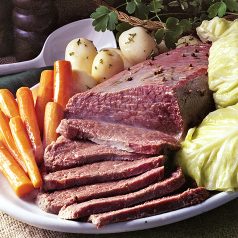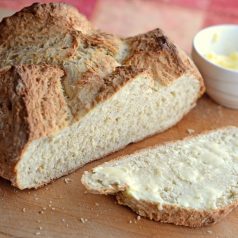
Corned Beef & Cabbage
You needn’t be Irish to celebrate the American food traditions of St. Patrick’s Day. This recipe will help you pull together a traditional one-pot meal using simple, hearty ingredients—perfect for the occasion!

You needn’t be Irish to celebrate the American food traditions of St. Patrick’s Day. This recipe will help you pull together a traditional one-pot meal using simple, hearty ingredients—perfect for the occasion!

You needn’t be Irish to celebrate the food traditions of St. Patrick’s Day. You’ll find all the components you’ll need in our weekly sale display from March 10th – 16th and this recipe will help you pull this traditional one-pot meal together!

You needn’t be Irish to celebrate the food traditions of St. Patrick’s Day. You’ll find all the components you’ll need in our weekly sale display from March 11th – 17th and this recipe will help you pull this one-pot meal together!

You needn’t be Irish to celebrate the food traditions of St. Patrick’s Day. You’ll find all the components you’ll need in our weekly sale display from March 12th – 18th and this recipe will help you pull this one-pot meal together!

You needn’t be Irish to celebrate the food traditions of St. Patrick’s Day. You’ll find all the components you’ll need in our weekly sale display from March 7th – 13th and this recipe will help you pull it all together!

The oldest known reference to a published Soda Bread recipe comes from the November 1836 edition of Farmer’s Magazine in London, referencing a recipe published in an Irish newspaper in County Down, Ireland that same year. The author of the recipe proclaims “there is no bread to be had equal to it for invigorating the body, promoting digestion, strengthening the stomach, and improving the state of the bowels!”. The use of soda ash in baking bread is originally credited to American Indians who used it to leaven their bread prior to 1800, though the state of poverty in Ireland in the early 1800’s made it the simplest and least expensive daily bread to put on the table, thus making it their adopted method of choice and one that is now synonymous with Irish culture.
All recipes for traditional soda bread contain nothing more than flour, baking soda, buttermilk, and salt. This was a daily bread that didn’t keep long and had to be baked every few days. It was not until well past the mid 19th century that recipes began including whiskey, candied fruit, caraway seeds, raisins, or other festive ingredients. This particular recipe from The Society for the Preservation of Irish Soda Bread offers options for both – just in time for St. Patrick’s Day!

The oldest known reference to a published Soda Bread recipe comes from the November 1836 edition of Farmer’s Magazine in London, referencing a recipe published in an Irish newspaper in County Down, Ireland that same year. The author of the recipe proclaims “there is no bread to be had equal to it for invigorating the body, promoting digestion, strengthening the stomach, and improving the state of the bowels!”. The use of soda ash in baking bread is originally credited to American Indians who used it to leaven their bread prior to 1800, though the state of poverty in Ireland in the early 1800’s made it the simplest and least expensive daily bread to put on the table, thus making it their adopted method of choice and one that is now synonymous with Irish culture.
All recipes for traditional soda bread contain nothing more than flour, baking soda, buttermilk, and salt. This was a daily bread that didn’t keep long and had to be baked every few days. It was not until well past the mid 19th century that recipes began including whiskey, candied fruit, caraway seeds, raisins, or other festive ingredients. This particular recipe from The Society for the Preservation of Irish Soda Bread offers options for both – just in time for St. Patrick’s Day!